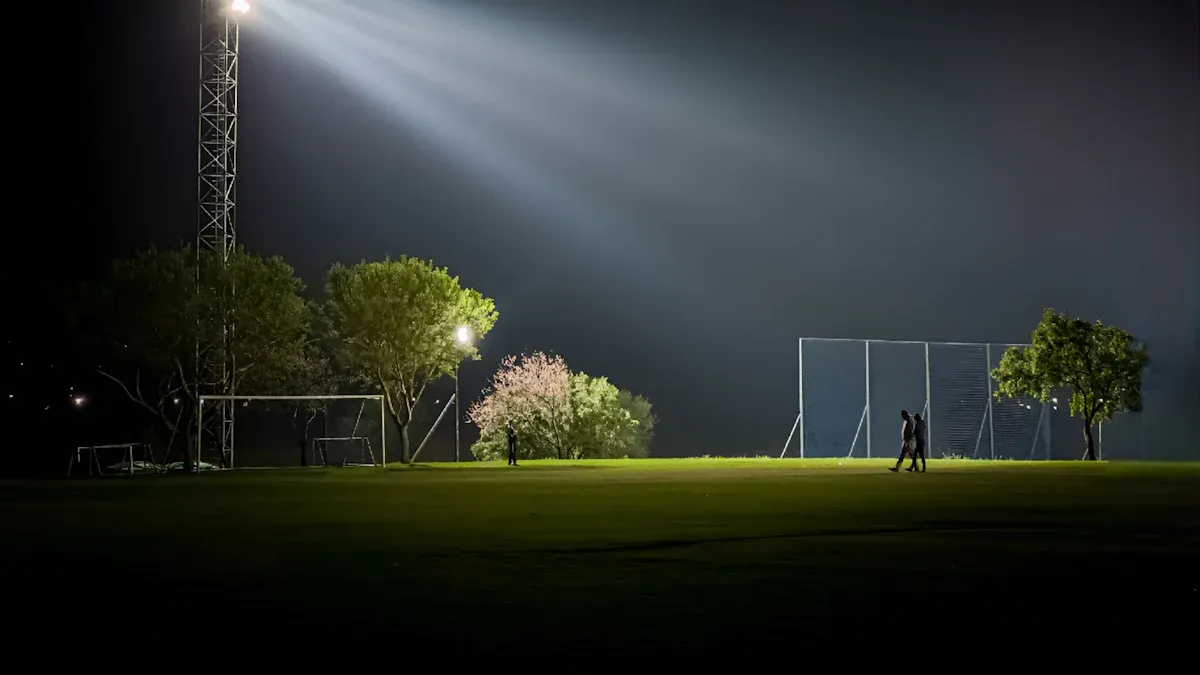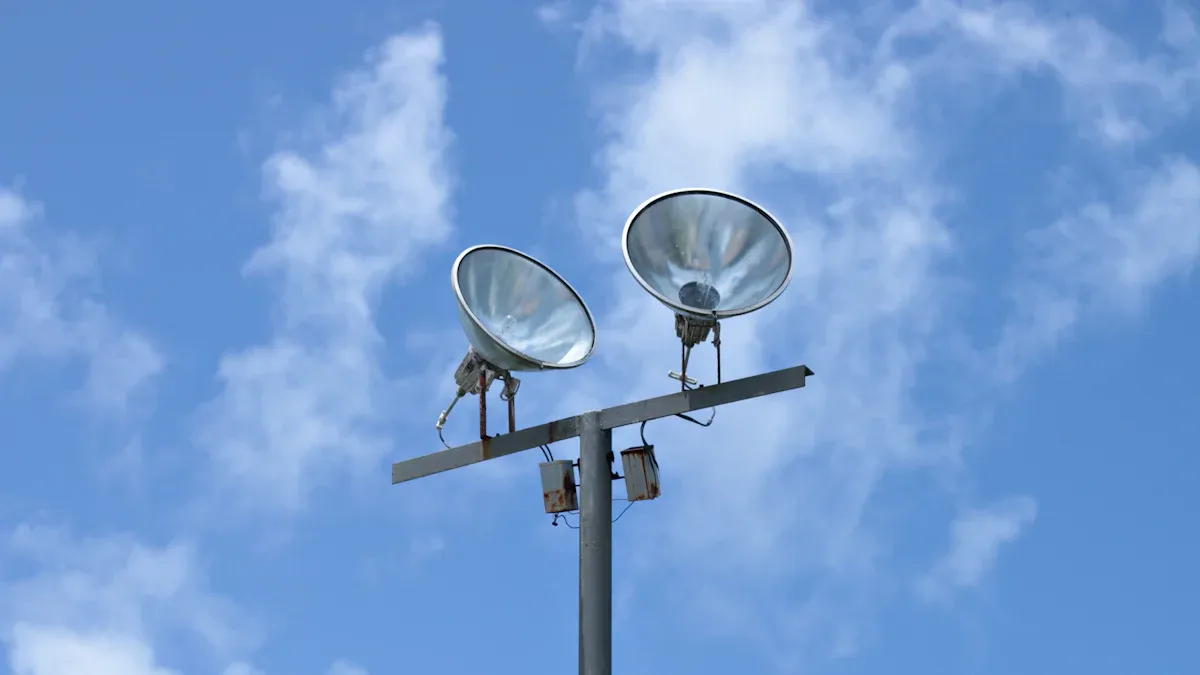Light Flood Solutions: How to Choose the Right Brightness and Coverage for Your Outdoor Space

Choosing outdoor lights isn’t just about making it brighter; it’s also about safety, usefulness, and aesthetics. Whether it’s a small patio or a big backyard, good lighting solutions like Light Flood Solutions can make a significant difference. But how do you pick the right brightness and coverage? Should you choose a small Lawn Light or a powerful Led Light? Small areas may need around 700 lumens, while larger spaces might require over 10,000 lumens. Selecting the right light ensures optimal brightness for your space. Additionally, Solar Floor Lights are an excellent choice for energy savings. Let’s explore how to choose the best lights for your outdoor areas.
Key Takeaways
Learn about lumens to pick the right brightness. Small spaces need 700-1,000 lumens. Big areas need 2,000-5,000 lumens.
Think about beam angles when choosing lights. Narrow beams light small spots. Wide beams brighten big areas for safety and visibility.
Use LED lights for energy savings. They cost less, last longer, and are better for the environment than regular bulbs.
Pick strong lights with high IP ratings. IP65 or higher means lights can handle rain, dust, and bad weather.
Add motion sensors or dusk-to-dawn sensors. These make lighting safer, save energy, and are easy to use outdoors.
Understanding Brightness and Coverage

What Lumens Mean for Outdoor Lighting
Lumens tell you how bright a light is. This helps create the right mood and keeps areas safe. Unlike watts, which show energy use, lumens focus on brightness. More lumens mean brighter light.
For example, a driveway or backyard needs enough light to see clearly. A cozy patio, however, might need softer light for a calm feel. Knowing about lumens helps you pick the best lights for your space.
How Many Lumens You Need: Tips for Different Areas
The number of lumens depends on the size of your space. Small areas, like porches or garden paths, need 700 to 1,000 lumens. This gives enough light without being too bright. Bigger spaces, like backyards or parking lots, need more lumens for full visibility.
Here’s a simple guide to match lumens to your space:
Small spaces need 700 to 1,000 lumens for good lighting.
Large spaces need higher lumens for better coverage and visibility.
If unsure, start with fewer lumens and adjust later. Many Light Flood Solutions let you change brightness, so finding the right level is easy.
Beam Angles and How They Spread Light
Beam angles decide how light spreads in an area. A narrow beam, like 20 degrees, lights up one spot. This works well for trees or statues. A wide beam, like 120 degrees, lights up bigger areas. This is great for patios or driveways.
Here’s a table showing brightness levels for different places:
Environment | |
|---|---|
Office Workspaces | 30-50 |
Retail Spaces | 100-200 |
Warehouses | 10-30 |
When picking Light Flood Solutions, think about the beam angle you need. Wide angles cover more space, while narrow ones highlight special features.
Key Factors in Choosing Light Flood Solutions
Purpose and Location: Security, Aesthetics, or Functionality
Think about why and where you need floodlights. Are they for safety on your driveway? Or do you want to make your garden look cozy? The purpose and location will help you decide.
For safety, pick bright lights with wide beams. These light up large areas and make it easy to see movement. For a nice look, softer lights with adjustable angles work well. For patios or sports areas, choose lights that balance brightness and coverage.
Here’s how floodlights can meet your needs:
Benefit | Description |
|---|---|
Bright floodlights reduce accidents in dark areas. | |
Flexible and Customizable | Use floodlights for gardens, patios, or sports fields. |
Weatherproof Design | Strong materials make them last in bad weather. |
Match your floodlight to its purpose for the best results.
Energy Efficiency and LED Technology
Saving energy is important for outdoor lighting. Old floodlights use more power, but LED ones save energy and still shine bright.
LEDs have many benefits. They give more light using less energy. They don’t get very hot, so they’re safer and last longer. You won’t need to replace them often.
Here’s how LEDs compare to older lights:
Metric | LED Floodlights | Metal Halide Floodlights |
|---|---|---|
100-150 lm/W | 65-115 lm/W | |
Heat Generation | Low (10-20%) | High (70-80%) |
Annual Energy Cost (50,000 sq ft facility) | $5,200-$7,800 | $12,500-$18,000 |
Carbon Footprint (Annual CO₂ emissions) | 22-35 tons | 55-80 tons |
Switching to LEDs saves money and helps the planet. It’s good for you and the environment.
Durability and Weather Resistance: IP Ratings and Materials
Outdoor lights need to handle tough weather. Pick ones that resist rain, dust, and heat. IP ratings and materials show how strong they are.
IP ratings tell you how well lights block dust and water. For example, IP65 means it resists dust and water sprays. IP68 means it’s fully dustproof and can go underwater.
Here’s a guide to IP ratings and materials:
IP Rating | Description |
|---|---|
IP65 | Blocks dust and water sprays. |
IP68 | Fully blocks dust and works underwater. |
Material | Type |
----------- | ------------- |
Anodized Aluminum | Resists rust in tough conditions. |
Stainless Steel | Great for coastal or industrial areas. |
Choose durable floodlights with high IP ratings. They’ll last longer and work well in any weather.
Additional Features: Motion Sensors, Dusk-to-Dawn Sensors, and Design
Extra features in outdoor floodlights can make a big impact. Motion sensors, dusk-to-dawn sensors, and stylish designs improve function, save energy, and look great. Let’s see how these features help.
Motion Sensors: Light Only When Needed
Motion-sensing lights are great for saving energy and adding safety. They turn on when they sense movement, so they don’t stay on all night. This is helpful for driveways, walkways, or keeping intruders away.
Picture arriving home late at night. As you near your driveway, the lights turn on, lighting your way and making you feel safe. But remember, motion sensors might activate from animals or moving branches. Placing them carefully can avoid false alarms.
Dusk-to-Dawn Sensors: Easy and Automatic
Dusk-to-dawn lights are perfect for steady lighting without effort. These lights adjust to natural light, turning on at sunset and off at sunrise. They keep your space lit all night without needing switches.
This feature is both useful and elegant. It keeps areas safe by ensuring they’re always lit in the dark. It also highlights pathways or gardens, adding beauty to your yard. Smart dusk-to-dawn lights only work when needed, saving energy and helping the environment.
Tip: Want a simple option? Dusk-to-dawn lights are low-maintenance. They work quietly, letting you enjoy your outdoor space.
Design: Combining Style and Function
Floodlights don’t have to look boring. Modern designs mix style with usefulness. Whether you like sleek fixtures or decorative ones, there’s a design to match your home.
Think about where to place your lights. Wall-mounted lights can show off your home’s exterior. Ground-mounted ones can brighten paths or gardens. Picking the right design makes your lights useful and improves your outdoor space’s look.
When choosing Light Flood Solutions, pick models with these features. They’ll make your lighting setup smarter, more stylish, and just right for you.
Practical Tips for Picking the Best Floodlight
Measuring Your Space for Proper Light Coverage
To pick the right floodlight, know your space size. Measure your outdoor area to ensure the light fits well. Use tools like photometers to check light levels in different spots. Follow these tips for better results:
Pick photometers with Class A specs for accurate readings.
Choose tools with low error rates (f’1≤3%, f2≤1.5%) to avoid mistakes.
Use photometers with at least 0.01 lx resolution for dim areas.
Calibrate your tools every 1–2 years to keep them accurate.
These steps help you avoid too much or too little light. This ensures your Light Flood Solutions work perfectly.
Reducing Light Pollution and Being Neighbor-Friendly
Bright lights can spill into areas they shouldn’t, causing problems. You can stop this by following these easy tips:
Add shields to lights to aim beams downward and focus them.
Use energy-saving LEDs with softer tones to cut glare.
Install smart lights with motion sensors to adjust brightness only when needed.
Set timers or dimmers to control how long lights stay on.
These ideas save energy, protect the environment, and keep neighbors happy.
Testing Placement and Adjusting Light Height
Where you place and how high you mount lights matters a lot. For general lighting, mount them 8–12 feet high and tilt them down at 30 degrees. For security, place them 12–15 feet high to cover more space and reduce shadows.
For entrances, mount lights 8–12 feet high with a downward angle. In garages, go higher—10–15 feet—to avoid harsh shadows. Test different spots to get the best light coverage and safety.
Picking the right outdoor lights can improve your space. It also keeps it safe and energy-efficient. Lumens show how bright a light is. For backyards, 2,000 to 5,000 lumens work well. Beam angles decide how light spreads. A 15° angle focuses light on one spot. A 120° angle spreads light over a wide area. LEDs are energy-saving and last much longer than old bulbs. They use 85% less energy and can last 25 times longer. Strong lights are important too. Choose IP65-rated lights to handle bad weather.
Think about what you need before buying. Do you want safety, a nice look, or both? Light Flood Solutions have many choices to fit your needs. Measure your space, check features, and pick a design that matches your outdoor area.
FAQ
What is the best brightness for outdoor floodlights?
The ideal brightness depends on your space. For small areas like porches, 700-1,000 lumens work well. Larger spaces, like backyards, need 2,000-5,000 lumens. Always match the brightness to your needs for safety and comfort.
How do I prevent my floodlights from bothering neighbors?
You can reduce light pollution by using shields to direct light downward. Motion sensors and dimmers also help control brightness. Choosing warm-toned LEDs minimizes glare, keeping your neighbors happy.
Tip: Test your lights at night to ensure they don’t spill into unwanted areas.
Are LED floodlights worth the investment?
Absolutely! LEDs save energy, last longer, and produce less heat. They’re eco-friendly and cost-effective in the long run. Plus, they offer consistent brightness without frequent replacements.
What does an IP rating mean for outdoor lights?
IP ratings show how well a light resists dust and water. For outdoor use, look for IP65 or higher. This ensures your lights can handle rain, dust, and tough weather conditions.
Can I install floodlights myself?
Yes, if you’re comfortable with basic tools and wiring. However, for complex setups or high-mounted lights, hiring a professional ensures safety and proper installation.
Note: Always follow the manufacturer’s instructions for safe installation.
See Also
Transform Outdoor Areas With RGB Flood Lights For Events
Expert Design And Installation Tips For Flood Lighting Systems
Selecting Dependable Solar Lights For Outdoor Areas In 2025
Top Five LED Outdoor Lighting Options For Enhanced Safety
Selecting The Perfect LED Street Light For Community Projects

